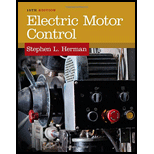
Electric Motor Control
10th Edition
ISBN: 9781133702818
Author: Herman
Publisher: CENGAGE L
expand_more
expand_more
format_list_bulleted
Concept explainers
Question
Chapter 38, Problem 3SQ
To determine
Explain how the speed control is accomplished.
Expert Solution & Answer
Trending nowThis is a popular solution!

Students have asked these similar questions
Can you elaborate on how to determine the
direction along with solving the requirements?
in a lossless medium for which
Robons Myst, and has;
πl=-
= - al cos (wt-z) ax +0.5 Silwt-z) ay Ahm
Calculate Er, W, E
V/m
the electric field in free space is given by
E. 50 Cos [2π lot - B2] ay
a) find the direction of the wave propagation
b) Calculate W, B, A, S
4- magnetic medium
Ex:- A plane wave in non-.
(Mr=1) has:
E. 50 Sin (10³t + 2Z) ay v/m
a) direction of propagation and H-
b) A, f, Er, dp
Solution
f
Z
хн
Wave
His in
ax
Wave
is
in
az
B=2,
w=10
8
YE
How?
Chapter 38 Solutions
Electric Motor Control
Knowledge Booster
Learn more about
Need a deep-dive on the concept behind this application? Look no further. Learn more about this topic, electrical-engineering and related others by exploring similar questions and additional content below.Similar questions
- Can you elaborate on how to determine the direction along with solving the requirements? A plane wave in non- (Mr=t) has: magnetic medium E. 50 Sin (10³t + 2Z) ay v/m a) direction of propagann and H. b) A, f, Er, dp H&arrow_forwardB:Find the roots of the following equation using NR method at the end of second iteration.start with V-4, V2-8 V₁*V2-50.... (1) Vi+V2 =15... (2)arrow_forwardB:Find the roots of the following equation using NR method at the end of second iteration.start with V-4, V2S V₁*V2=50... V₁+V₂ =15 (1)arrow_forward
- a) Determine the setting of the overload protection of the circuit breaker intended to protect a 50hp, 380V, IV-pole motor, powered by a unipolar copper-PVC conductor circuit, with a cross-section of 25mm², installed in a buried conduit: The short-circuit current at the motor terminal is 5KA. It is assumed that the overload current of the conductor throughout its useful life is controlled and will not exceed 100 hours for 12 consecutive months or 500 hours throughout the useful life of the conductor. Data: fp = 0.86; efficiency = 0.92 a) Determine the minimum operating time of the circuit breaker in the event of a short-circuit at the motor terminals.arrow_forwardQ1:A: Derive four elements only of diagonals Jacobian matrix of NR method in polar coordinate for a system consist of 4 buses, bus 1 is slack and the other three buses are PQ buses.arrow_forwardPls show neat and whole solutionarrow_forward
arrow_back_ios
SEE MORE QUESTIONS
arrow_forward_ios
Recommended textbooks for you
